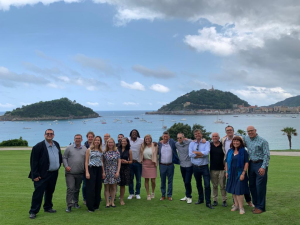Peter Dahlgren : MEDIA AND POLITICAL ENGAGEMENT. Citizens, Communication and Democracy (Cambridge University Press, 2009).
This book by Peter Dahlgren, Professor of Media and Communication Studies at the University of Lund (Sweden) is more ambitious than its title might suggest. The media, in fact, do not figure centrally within the first five chapters of the book, even if some parts are dedicated to them and if the media are the final aim of the book. In these early chapters, there is instead a theory of the preconditions of democracy, a theory which prepares for the last three chapters, which are devoted to television and new practices made possible by the internet.
Based on an impressive mastering of the extensive English-language literature on the media and their relationship with democracy, the author begins by introducing the theoretical debates on contemporary democracy (Democracy in Difficult Times), the evolution of the media (Media Alterations), forms of citizen action (Citizens and Agency) and deliberative political practices (Engagement, Deliberation and Performance). Chapters 3 and 4, dedicated to citizenship and the idea of deliberative democracy are, independently from the subject of the book (the media and political engagement), an excellent, clear, dense synthesis of different interpretations of these concepts.
Chapter 5 is the culmination of the work. By systematizing the analyses of previous chapters, the author presents what he considers the six dimensions of “civic culture”. By this, he means that in a democracy, citizens are only active if there exists a favorable cultural environment beyond institutions which define democracy: “these structures and processes need to be populated by real-life people with democratic inclinations” (104). According to the author, there are six of these preconditions:
Knowledge. Citizens’ participation in democratic life requires knowledge (as well as the ability to acquire knowledge), whose structure is analyzed by the author (for example, one can distinguish “background knowledge”, consisting of stable explanatory schemas, from “incoming new information”). It is clear that the evolution of contemporary media, in the broadest sense, is significantly changing the manner and means of acquiring this knowledge, by promoting or restricting democratic debate.
Values. Democracy can only work on a normative basis (both “substantial” – through the values of equality, liberty, justice, etc. – and “procedural”, through the values of openness, reciprocity, discussion, accountability, etc.) and only if citizens have the ability to be motivated by these norms (what philosophical tradition calls their “virtue”), to internalize them (on an intellectual level, but also on an emotional level) all while making their application an object of democratic debate. At this level as well, the evolution of contemporary media can promote citizens’ attachment to democratic values or threaten it (e.g. when these values are “under threat of economist and consumerist values” – as shown by the author in the paragraph devoted to “uncivic economism”, pages 20-22).
Trust. A democratic society can hardly function without “thin trust” (“the generalized honesty and expectations of reciprocity that we accord people we don’t know personally but with whom we feel we can have a satisfactory exchange”, 113) and, on the political level, without the trust citizens place in institutions and in their elected representatives. This trust does not exclude healthy mistrust (“trust with a built-in antenna for skepticism”), which is also essential to the functioning of democracy. The evolutions of contemporary media have also changed, in contradicting ways, this mix of trust and mistrust characteristic of democratic societies.
Spaces. There is democratic life only if there are spaces where citizens can meet and discuss, meet their representatives and discuss with them. Contemporary media are obviously reconfiguring these multiple spaces.
Practices. Democratic life requires a set of stable, individual and collective practices in which it can be embodied (voting, various debates, networking around specific objectives, etc.). Contemporary media are significantly opening the field of these practices.
Identities. Identities, in the sense of the awareness that participants in democratic life have of themselves, not only as citizens with basic political rights but as empowered political agents, are an essential piece of civic culture (the author strongly emphasizes the fact that these identities have a strong emotional content throughout the book). The fundamental task of media theorists is to analyze the effects of the media on identity makeup, on the opportunities they offer (“in regard to empowerment and valorized political community”) but also on the perspective of civic identity resulting from it (“we-ness” can also result nowadays from a sport or from a TV program!).
I will let the reader discover the very rich empirical content of the analyses of the final chapters, based on the theory that I have given very schematically, which are dedicated to the media, especially television and the internet.
Chapter 6, about television, is particularly original. P. Dahlgren notices a drift of television toward entertainment and consumption. But this fact does not lead to any nostalgic lamentation or elitist posture. Following Ellis, the author considers television as a “working through”, a medium “not providing any ultimate or definitive point of view, but rather offering its viewers vast amounts of transitory glimpses, preliminary meanings, multiple frameworks, explanations, and narrative structures for processing basic private as well as public concerns, many times touching on topics that are, if not fully political, at least incipient, or proto-political. These may or not at times coalesce as concrete political issues; often they remain at the level of perceptions and values” (133). Values being one of the six conditions of democracy, as we have seen, the author attempts to show, very convincingly, that even televised entertainment raises moral and political (or proto-political) problems, and provokes debates surrounding it, thus calling into question the dichotomy of information and entertainment: “the ongoing televisual treatment of value conflicts having to do with premarital sex, sexual preferences, abortion, gene manipulation, interethnic relations, and so on, in such diverse genres as dramatic series, soap operas, reality television, talk shows, situation comedies, and comic monologs are all indicative of television’s blurring of this dichotomy” (135). The same observation can also be made about identities, which often gain visibility and legitimacy by entertaining programs. These pages of the book invite us to consider popular culture differently: in its own way, it contributes to forging public space and to the emergence of political perspectives – while politics, in turn, borrows more forms of language from this popular culture every day. The author concludes on the idea that “in chatting and voting on issues about reality programs, joining online fan cultures, making use of fanzines, blogging about popular topics, (…) people, especially younger ones, are developing strong patterns of mediated engagements and participation” (144) and that television “despite all its familiar limitations, may at times help us move beyond the narrow definition of politics and the public sphere, and connect us to civil cultures in subtle, surprising and unintended ways” (148).
Regarding internet, the reader will discover the enlightening pages the author dedicates to spaces, and the critique he makes of Sunstein’s theory that the internet is doomed to fragment public space and send groups and individuals back into their cyber-ghettos (this theory is based particularly on the questionable premise that the goal of any political conversation is to reach a consensus, 165). It will discover, too, the nuanced conclusion that the author presents of the role of the internet in the formation of a global public space (166), and the final, balanced pages about youth (Media Generations).
This report has deliberately left out anything that can place P. Dahlgren’s perspective closer to or away from those of other authors and other theoretical trends in research on the media. Suffice to say that P. Dahlgren, whose perspective is clearly republicanist, constantly distances himself from Habermas’ theory of the public sphere and the idealization of democratic debate on which it relies. One of the lessons of the book is that citizens are not merely rational subjects, or in other words, that more now than ever, we must not oppose reason to emotions, representative democracy to citizens’ activity in a civil society, or the culture of elites to popular culture. From this book emerges a cautious optimism about the future of democracy (an optimism with a built-in antenna for skepticism, as the author puts it): the evolution of the media “reminds us of the need to rethink and reframe the way we analytically approach democracy” (201), reminds us that representative democracy in its current form is a “historically contingent undertaking” (201): “we cannot know what kind of media-based civic cultures will develop in the future, but the struggle for democracy, for present and future generations, will remain inexorably political” (202).
From this book emerges also some sort of wisdom, a desire not to split man into intellect and emotion, and at the same time, a desire not to divide men, a refusal of any haughty disdain for popular culture (a widespread leaning among intellectuals), and an attention to everything promising it may contain – which does not mean the abandonment of critical vigilance with regard to its ever-possible excesses.



